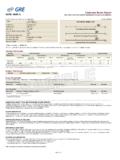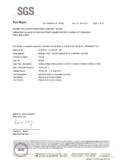Transcription of Appendix E Pump Test Report - hdrprojects.com
1 Appendix E. Pump Test Report GROUND-WATER EXPLORATION PROGRAM. LEGACY RIDGE, TOWN OF WOODBURY, NEW YORK. Prepared For: Legacy Ridge August 2007. Prepared By: LEGGETTE, BRASHEARS & GRAHAM, INC. Professional Ground-Water and Environmental Engineering Services 4 Research Drive, Suite 301. Shelton, CT 06484. TABLE OF CONTENTS. Page INTRODUCTION ..1. DRILLING EXPLORATION PROGRAM ..1. Bedrock Sand and Gravel TW-A ..3. PW-1 ..3. INSTALLATION OF PIEZOMETER ..3. INSTALLATION OF PRESSURE TRANSDUCERS ..4. 24+ HOUR PUMPING TEST ..4. WELL MONITORING PROGRAM ..5. Long-Term Yield of WATER GROUND-WATER EXPLORATION PROGRAM.
2 LEGACY RIDGE, TOWN OF WOODBURY, NEW YORK. INTRODUCTION. Leggette, Brashears & Graham, Inc (LBG) conducted an additional groundwater exploration program, aquifer testing program, and groundwater quality assessment on the Legacy Ridge parcel in the Town of Woodbury, NY. The objective of the groundwater exploration program was to locate, install test wells and perform aquifer performance test to demonstrate sufficient yield to augment the existing water-supply sources. Figure 1 shows the location of the site in the Town of Woodbury, Orange County, New York along with the existing production wells, test wells, monitoring wells, and piezometers used during the aquifer performance test.
3 DRILLING EXPLORATION PROGRAM. The additional exploration program conducted by LBG included test well drilling completed in both the bedrock and sand and gravel aquifers from March to June 2007. To date, three bedrock test wells and two sand and gravel test wells have been completed. The following is a discussion of the preliminary yield estimate of the test wells from the bedrock and sand and gravel aquifers, including data from a 24+ hour pumping test event conducted on a successful high- yield sand and gravel well (PW-1). A previous ground-water exploration program conducted by HDR Engineering, Inc. (HDR) in 2005 on the study parcel developed three successful sand and gravel production wells identified as TW-1, TW-2 and TW-4; with respective yields of 290, 120 and 34 gpm.
4 The wells are shown on figure 1. Details of the well completion reports of the existing water supply wells and monitoring wells completed under the supervision of HDR are provided in the Report Groundwater Exploration and Hydrogeologic Report , Town of Woodbury, Orange County, NY by HDR, Inc., January 2006 . -2- Bedrock Aquifer The bedrock geologic map from the Orange County New York, Ground-Water Resources Study (LBG, May 1995) shows complex bedrock geology on the study parcel. The initial bedrock well drilling program considered an area north of Trout Brook Road and west of Route 9. (Mineral Spring Road).
5 A prominent northeast to southwest trending trust fault bisects this portion of the study parcel, separating a granitic gneiss bedrock unit on the north of the fault; and Undifferentiated Lower Devonian and Silurian Rocks consisting of sandstone, shale and conglomerate rock unit s on the southern side of the fault. Fracture-trace maps were interpreted with additional layers of topography; bedrock geology; underling faults; geologic contacts; wells inventoried; sand and gravel deposits; and State and Federal wetlands to locate favorable locations to target high- yielding bedrock well. Locations which exhibit more than one of the above features are considered to be promising for drilling high- yielding bedrock well and the sites initially considered on the study parcel for drilling test wells exhibited a number of these favorable features.
6 Three bedrock test wells were drilled by Turnbull Well Drilling, Inc. from March to April of 2007 under the supervision of LBG. Bedrock test wells 1, 2 and 3 (BRW-1, 2, and 3) are shown on Figure 1. The well completion reports are presented in Appendix I. All three bedrock test wells yielded about 30 gpm at termination of drilling. The project team decided to terminate the bedrock test well drilling at completion of BRW-3, considering the well yields were considered marginal for the development of public water-supply sources. Sand and Gravel Aquifer Layne Christensen Company (Layne) was contracted in April of 2007 to drill test well locations in the sand and gravel aquifer, north of Trout Brook on the study parcel.
7 The initial drilling program completed three test borings (TB-1, 2 and 3) in the vicinity of BRW-1. Sand and gravel aquifer material was encountered in this area during drilling; however, the material was determined to not be suitable for the development of a high- yielding well. The test boring reports for TB-1, 2 and 3 are presented in Appendix II. LBG supervised the drilling of the two additional test borings and test wells drilled by Layne in June of 2007. The two six inch diameter test wells were completed as TW-A and PW-1. -3- (figure 1). The test boring reports and well construction diagrams for TW-A and PW-1 are located in Appendix II.
8 TW-A. TW-A was completed at a depth of 112 feet below land surface (bls). The well was screened from 102 to 110 feet bls with a 60-slot stainless steel screen. The well was screened in suitable sand and gravel aquifer material. A dense gray clay layer about 40- feet in thickness was encountered at a depth of 10 to 50 feet bls. The underlying bedrock was encountered at 112 feet bls and was composed of sandstone. The well was developed with repeated surging and pumping. PW-1. PW-1 was completed at a depth of 87 feet bls. The well screen was set at 80 to 87 feet bls with a 90-slot stainless steel screen. The well was screened in suitable sand and gravel aquifer material.
9 Similarly a dense gray clay layer about 20-feet in thickness was encountered at a depth of 10 to 30 feet bls. The bedrock was encountered at 90 feet bls and was composed of black shale. The well was developed with repeated surging and pumping. The initial pumping conducted during development indicated PW-1 had the higher yield potential, therefore, a short- term 24-hour pumping test was recommended on this well to determine the yield potential of a larger diameter production well. INSTALLATION OF PIEZOMETER. A diameter piezometer (PZ-A) was installed in the middle of the Trout Brook at a distance of about 60 fe et from the test well (PW-1).
10 A 12- inch length stainless steel screen (with drive point and coupled steel pipe) was driven into the bottom of the stream sediments to a depth of feet. The piezometer was developed by repeated well surging. The location of PZ-A is shown of figure 1. -4- INSTALLATION OF PRESSURE TRANSDUCERS. Prior to the aquifer performance test, pressure transducers (mini-trolls from Insitu, Inc.). were installed on June 25, 2007 in existing production wells (TW-1, TW-3, and TW-4);. monitoring wells (MW-2, MW-5, BRW-1), and in 12 Trout Brook Rd. (offsite homeowner well);. TW-A, and inside and outside of the piezometer, PZ-A.






